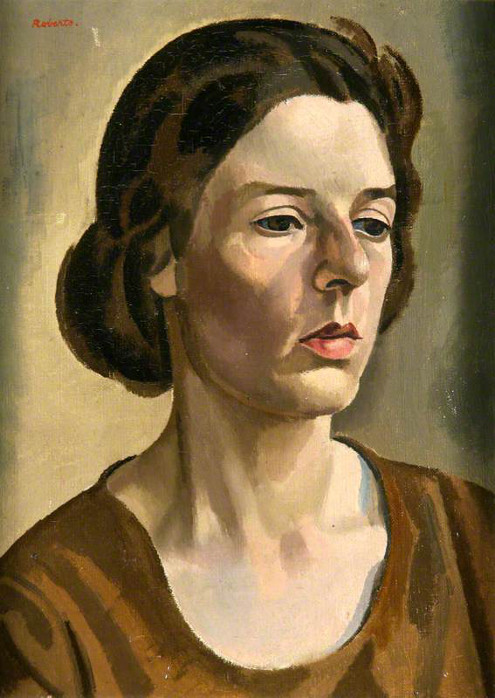AN ENGLISH CUBIST
WILLIAM ROBERTS:
Portrait of Miss Jane Tupper-Carey
Illustration © The Estate of John David Roberts. Catalogue information based on the catalogue raisonné by David Cleall. For this and full details of the exhibitions cited, see the links below. Any auction prices quoted may not include all fees and taxes, such as VAT and Artist's Resale Right charges.

Portrait of Miss Jane Tupper-Carey (aka Head of a Woman), c.1922
Oil on canvas, 41 cm x 31 cm
Rose Marie 'Jane' Tupper-Carey (1897–1982) was one of five children of Canon Albert Darell Tupper-Carey (who for a time was a chaplain in Monte Carlo and in 1938 became chaplain to King George VI) and his wife, Helen (née Chapman). A botanist, after taking an MSc, from 1922 she was a researcher under Professor J. H. Priestley in the Department of Botany in the University of Leeds; then in 1930 she moved to Cambridge, where she collected and translated literature on plant genetics for the Imperial Bureau of the Board of Agriculture. (She herself knew French, Italian German and Swedish.) In 1932 she married the Cambridge mathematician A. E. (Albert) Ingham (1900–67) – previously (1926–30) Reader in Mathematical Analysis at the University of Leeds – who in that same year published his classic work The Distribution of Prime Numbers. Her sister Edith was married to author and publisher Michael Sadlier (author of Fanny by Gaslight), son of the educationalist Sir Michael Sadler, who owned a number of works by Roberts. Sadler himself was a friend of her father and vice-chancellor of the University of Leeds in 1911–23.
PROVENANCE: Presented to the Contemporary Art Society by St John Hutchinson, 1924 > gift of CAS to Glynn Vivian Gallery, Swansea, 1927
EXHIBITION HISTORY: Chenil Galleries 1923 ('Properly to appreciate [Roberts's] powers the visitor should look first at such things as the "Portrait of Miss Tupper-Carey" . . . not because they are the best things in the exhibition, but because they make evident the fact that the treatment of form in some of the other works is deliberate, for the double purpose of racy comment and articulate design' – The Times, 9 Nov. 1923), Tate Gallery 1965 (as Head of a Woman – 'The artist does not remember who the sitter was' – 1965 catalogue)
Home page | Chronology | Bibliography | Collections | Exhibitions
News | Gallery | Auction results | The artist’s house | Contact
List of works illustrated on the site
Catalogue raisonné:
chronological | alphabetical